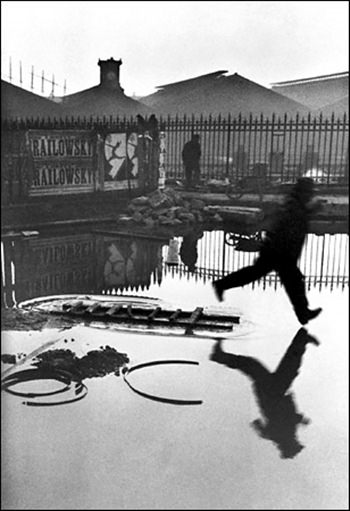
Henri Cartier-Bresson, the originator of the phrase in photography, “The Decisive Moment”, died in 2004, aged 95. However, he will be remembered for his contributions to photography forever. However, despite his fame and notoriety, he was never one to look for personal publicity, and in fact hid from it.
He was born in France in 1908 and initially studied painting, following much of the Surrealist school of thought of the time. However, by the time he was 22 years old he had dropped art for photography, but began to apply the art concepts he had been exposed to towards photography.
One of the factors that allowed Cartier-Bresson to do this was the advent of the small portable cameras, such as the Leica fitted with a 50 mm lens, which was to become Cartier-Bresson’s favorite instrument. He believed that the photographer had to become part of what was going on, and after becoming ‘in tune’ with the subject, it was then possible to capture the essential moment, the very essence of the event. This was explained by Cartier-Bresson in the foreword to his book, published in 1952, Images a la Sauvette (The Decisive Moment). He called it “The simultaneous recognition, in a fraction of a second, of the significance of an event as well as the precise organization of forms which give that event its proper expression.”
With this concept and the portable lightweight camera, Cartier-Bresson became one of the principal ‘street’ photographers. A true journalist with a camera – a photo-journalist. He would record not just a parade, but also the people watching the event, and their reactions to the event.
Take a look at the classic photo to illustrate the decisive moment. The shot was taken in 1932 at the Place de l’Europe, where the marooned man has finally realized that there is no way out, and having made the decision, launches himself off the ladder. That split second, that decisive moment caught by Cartier-Bresson in such a way the viewer can feel the moment still today, 72 years later. In his words, “There was a plank fence around some repairs behind the Gare Saint-Lazare train station. I happened to be peeking through a gap in the fence with my camera at the moment the man jumped.”
He recorded the Spanish Civil War in the 1930’s and then WW II, but was finally captured and he became a POW. He escaped three years later, and was there to record the liberation of Paris from the Germans.
Of course, he was by that stage becoming an icon, and in 1947 joined forces with two other ground-breaking photojournalists, Robert Capa and David Seymour to form the Magnum agency. However, for Cartier-Bresson, news was much more than the photo-journalists were showing. It was necessary to get behind the scenes.
Cartier-Bresson and his confreres forged a name for hard hitting news photography. Cartier-Bresson spent almost 20 years there, covering Mao Zedong’s victory in China and the death in India of nationalist movement leader Mahatma Gandhi.
Regarded as one of the pioneers of photojournalism, his pictures now hang in art galleries around the world, with a retrospective in Europe to be extended to allow more visitors the chance to view his work.
Friend and fellow photographer Lord Snowdon paid tribute to him saying, “He was brilliant. I will miss him very much. I don’t think he’d like his work to be called art, he would like to be remembered as an anonymous figure. His books record moments that can’t be captured again.” Again that concept of the ‘decisive moment’.
But by 1975 he gave up photography. “All I care about these days is painting – photography has never been more than a way into painting, a sort of instant drawing.”
Ex-French President Jacques Chirac said Cartier-Bresson’s death was a major loss to his country. “France loses a genius photographer, a true master, and one of the most gifted artists of his generation and most respected in the world.”
In 2004, the world lost a photographer who had vision and the ability to record his vision in a way the world could understand. The decisive moment will always belong to Henri Cartier-Bresson.
 |
 |
 |





